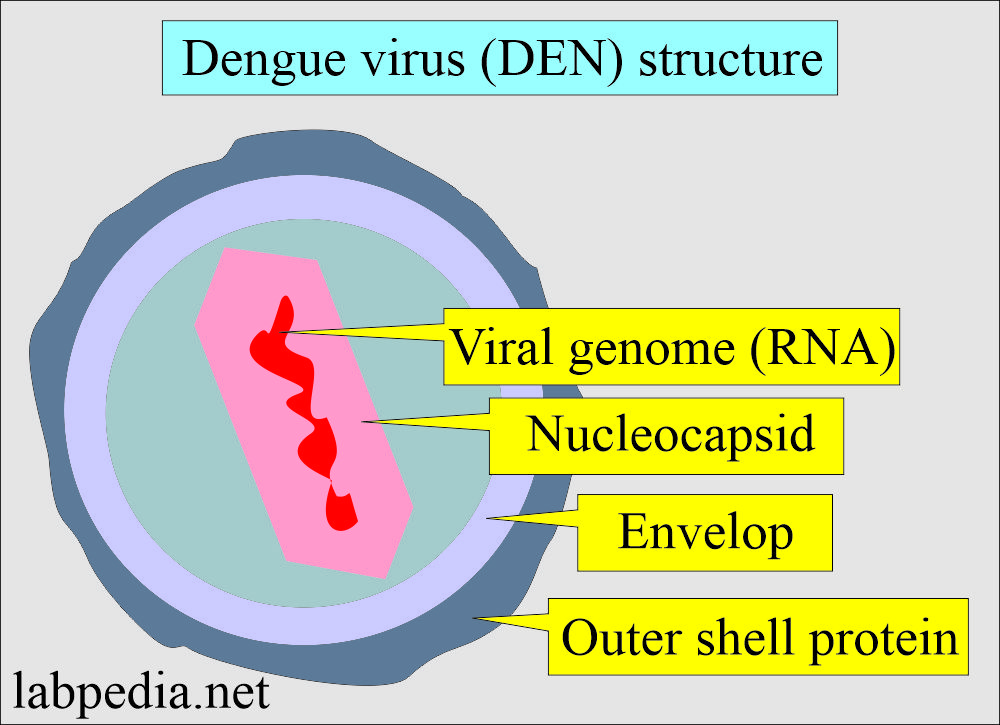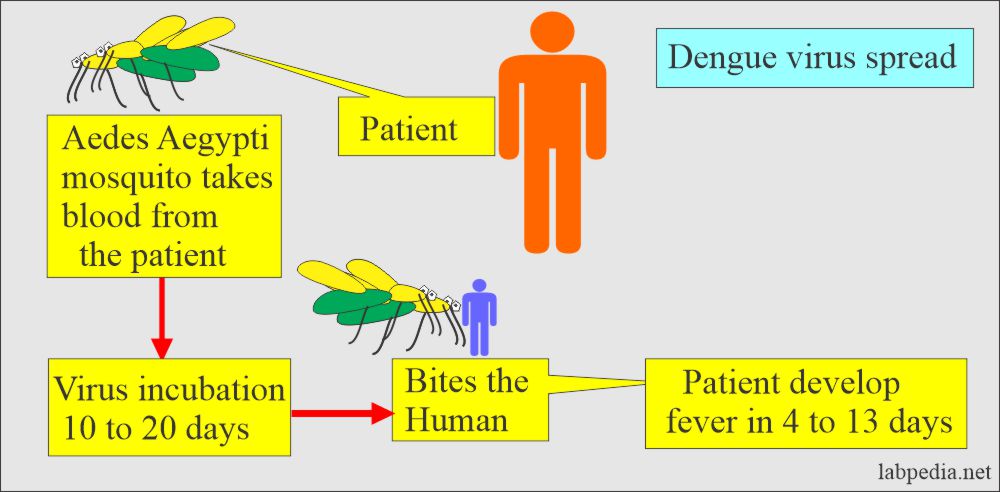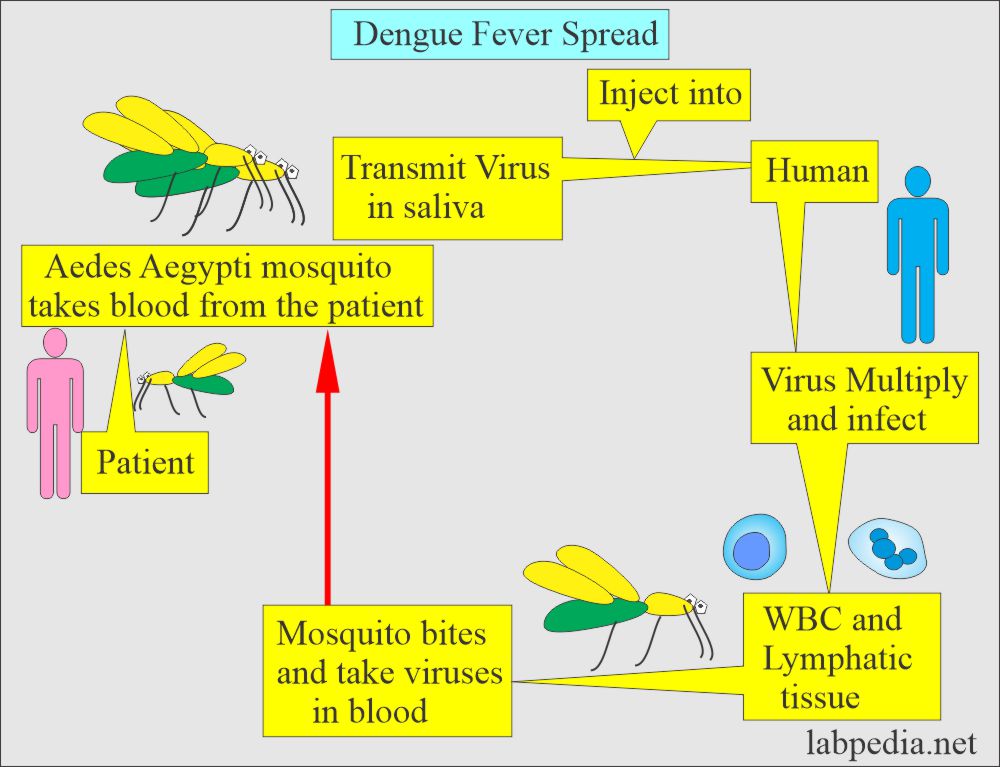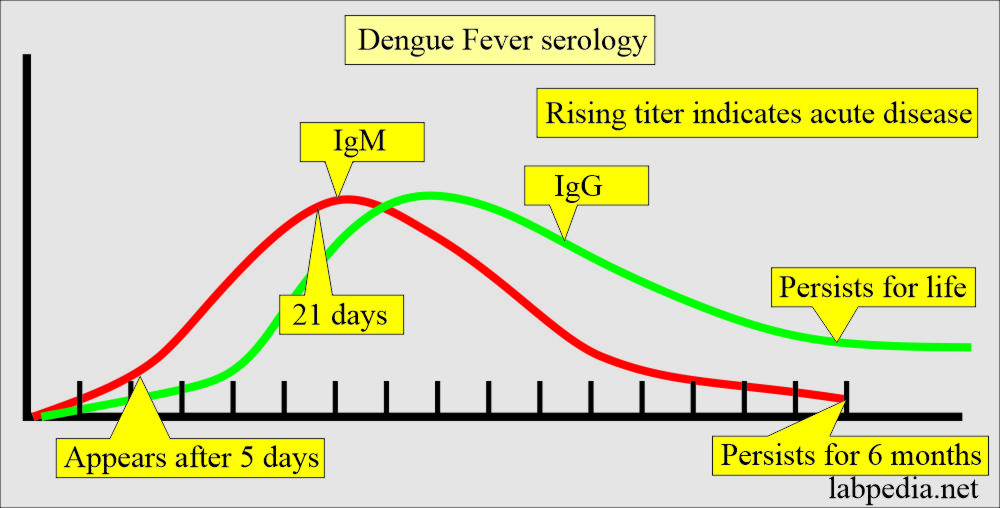Dengue Fever, Dengue Hemorrhagic Fever
Dengue Fever (Break-bone fever)
What type of Sample is needed?
- The patient’s blood is needed.
How will you Define Dengue Fever?
- The Dengue virus causes dengue fever. It is also called Break-Bone Fever.
- The Dengue virus may cause Dengue hemorrhagic fever (DHF).
- It is an endemic tropical disease due to single-stranded RNA belonging to the Flavivirus genus.
- It is transmitted by the Aedes aegypti mosquitoes (day-biting mosquitos), found in urban areas, and it prefers to feed on humans.
Epidemiology of Dengue Fever
- Dengue fever is the most common and most important arthropod-born viral (arbovirus) disease most common in tropical and subtropical people.
- It is found in Southeast Asia, the Indian subcontinent, Pakistan, the Western Pacific, and Central and South America.
- It is found in >100 countries in the tropics and subtropics.
- WHO (2004) estimated 50 million Dengue fever and 500,000 cases of Dengue hemorrhagic fever.
- It is transmitted by mosquitos.
- Its incidence recently increased to 40% to 50% of the world population is at risk.
- People living or traveling to tropical countries are at risk
- Four serotypes of the Dengue (DEN) virus (Flavivirus) cause dengue fever.
- DEN-1
- DEN-2
- DEN-3
- DEN-4
- It may lead to:
- Dengue hemorrhagic fever.
- Dengue shock syndrome.
What is the Dengue virus structure?
- Dengue virus is a roughly spherical virus.
- It is composed of a viral genome (RNA).
- Surrounded by viral capsid.
- Then is the viral envelope.
- Outermost is the shell of protein.
How will the Dengue virus spread?
Dengue fever is transmitted by mosquitoes, and there are two types.
- Aedes aegypti.
- Aedes albopictus
- The Serotypes of Dengue virus (DEN virus) distinguished by Complement fixation and neutralization test are:
- Dengue Den-1
- Dengue Den-2
- Dengue Den-3
- Dengue Den-4
- Immunity is specific to each serotype.
- Dengue virus is transmitted by female mosquitoes, mainly of the species Aedes aegypti and, to a lesser extent, Aedes albopictus.
- These types of mosquitoes are present throughout the world. These Insects that transmit disease are called Vectors.
- The disease is widespread throughout the tropics and is influenced by rainfall, temperature, and unplanned urbanization.
- This will spread to susceptible populations, usually by the viremic travelers; in that case, epidemic spread ranges from 50% to 70%.
- WHO estimates that about 40% of the world population is at risk. There is no discrimination of the age group because all age groups are at risk.
- The epidemic of dengue hemorrhagic fever occurred in the last 20 years in East Africa, Sri Lanka, and Latin America.
- Dengue is the second febrile disease after malaria in travelers coming from developing countries.
Immunity to Dengue Fever:
- Recovery from infection by one serotype provides lifelong immunity against that serotype.
- But still, you are at risk of the other three sub-serotypes.
- There is no direct spread from the patient. So, no worry about handling the patient.
- Cross-reactive immunity is partial and temporary.
What are the Signs and Symptoms of Dengue Fever?
- The incubation period is usually 4 to 7 days after the mosquito bite.
- History of travel from the dengue-endemic area.
- Dengue infection may range from:
- Asymptomatic patients.
- Severe hemorrhagic fever.
- Dengue shock syndrome (Fatal shock).
- Dengue hemorrhagic fever is seen more commonly in children than adults.
- Dengue fever is a self-limited biphasic fever disease.
- 50% of the children are asymptomatic.
- This disease is more severe in adults.
- After the incubation period:
- The patient has flu-like signs and symptoms.
- These signs and symptoms last for 3 to 10 days.
- In some cases, it becomes lethal and is called severe Dengue fever.
- There are sudden:
- Fever, mostly high-grade fever.
- The patient may have chills.
- The fever is biphasic, initially 3 to 7 days, and then remission a few hours to 2 days.
- There is a sore throat.
- There is a headache.
- Muscle pain leads to severe myalgias.
- Joint pain (arthralgias). This is more common in serotype 2.
- There is a characteristic skin rash like measles. These rashes may be in the maculopapular, morbilliform, or petechial form.
- 25% of the cases may show heart involvement.
- 5% may show fulminant hepatitis.
- The patient may go into depression.
- When the disease is severe and may lead to bleeding, it is called Dengue hemorrhagic fever due to low platelet count.
- High fever, hypotension, hemorrhage (GI bleeding), and shock are usually due to second or third-time infection.
- Another complication is low blood pressure, which leads to Dengue shock syndrome.
- Some patients may show the following:
- Ecchymosis.
- Gastrointestinal bleeding.
- Epistaxis.
What are the Signs and symptoms of Dengue hemorrhagic fever (DHF)?
- In the case of Dengue hemorrhagic fever, may see:
- This is a serious and life-threatening disease.
- This will affect more children or patients with previous infection by any type of dengue virus.
- Restlessness.
- Epistaxis.
- Abdominal pain.
- The gastrointestinal area may show bleeding, tenderness, and ascites.
- In DHF, there is vascular damage and disseminated intravascular coagulation (DIC) with spontaneous bleeding.
- In some cases, DHF progresses to circulatory collapse called Dengue shock syndrome.
- The mortality rate is 10% to 40%, and most of these are children.
- DHF is characterized by increasing hematocrit due to plasma leakage and decreased platelet count.
- There is a positive tourniquet test.
- There may be bleeding into the skin.
How to Prevent Dengue Fever?
- There is no commercially available Vaccine.
- Try to stay away from the affected area.
- Try to reduce or eradicate the mosquitoes in that area.
- Try to avoid biting by this mosquito.
- Do the proper disposal of waste and garbage.
- Try to remove all possible places where the mosquito can survive.
- Apply adequate insecticides to water storage containers every week.
- Try to stop the entry of mosquitoes from the windows or doors.
How will you Diagnose Dengue Fever?
- This may be diagnosed with the signs and symptoms of fever, nausea, vomiting, rashes, and generalized pain.
- Laboratory tests are:
- Low blood count (WBC are 2000 to 5000 /µL).
- WBC shows toxic granulations, and there are marked atypical lymphocytes.
- Low platelet count.
- Positive tourniquet test.
- Raised hematocrit due to hemoconcentration.
- ESR is usually normal if it is raised before considering another differential diagnosis.
- Low blood count (WBC are 2000 to 5000 /µL).
- In DHF, there is prolonged clotting time, PT, and PTT.
- In DHF, fibrinogen levels may be decreased.
- Blood urea is raised.
- Liver function tests show raised transaminases (these may be 500 to 1000 U/L).
- Serum Na+ and albumin are reduced.
- In some cases may see proteinuria and even hematuria.
- Confirmatory tests are virus isolation. This can be done in cell culture.
- Virus isolation is possible in the acute phase of the disease. Virus culture is positive within the first 5 days of infection, where the sensitivity is <50%.
- Can take a culture from the liver autopsy tissue.
- The virus can be detected from CSF or serum by ELIZA.
- PCR -Nucleic acid detection by PCR can be done.
- Viral antigen (NS1) can be detected. This is positive in more than 90% of the primary infection in the febrile phase.
- Serological tests detect dengue virus-specific antibodies.
- These antibodies are of:
- IgM antibody. This can be detected by ELIZA within 5 days and persists for months.
- Diagnosis of the disease in the later stages of the infection.
- IgG antibody appears soon after IgM, and it persists for life; titer may be 1:1280
- Both IgG and IgM are produced after 5 to 7 days.
- IgM antibody indicates acute primary infection. This is undetectable after primary infection for up to 30 to 90 days.
- IgM may be produced in reinfection.
- IgM antibody. This can be detected by ELIZA within 5 days and persists for months.
- These antibodies are of:
What are the Complications due to Dengue Fever?
- There may be:
- Respiratory involvement like pneumonia.
- Hepatitis.
- Orchitis.
- Oophoritis.
- Retinal hemorrhage.
- Depression.
- Encephalitis.
- Bacterial superinfection may occur in older patients.
- Dengue hemorrhagic fever is characterized by a decreased platelet count.
- Dengue shock syndrome
How will you treat Dengue Fever?
- For pain, give pain reliever drugs. Acetaminophen can be used. Avoid Aspirin and NSAIDs because they may cause bleeding.
- In the case of hemorrhagic dengue or fever, the patient needs plenty of fluids.
- There is no vaccine available.
- WHO reported in late 2015 and early 2016 that the first Dengue vaccine “Dengvaxia (CYD-TDV), by the company Sanofi Pasteur, was registered for some countries. This can be used between the ages of 9 to 45 years for people living in endemic areas.
What is the outcome of Dengue fever?
- There may be a 2.5% mortality due to dengue fever.
Questions and answers:
Question 1: What are the complications of Dengue fever?
Question 2: What are common complications of Dengue fever?





which medication specific for it
Please consult your physician.
Nice Summary.
Mehboob Fatteh
Thanks a lot.
Very precise informative article